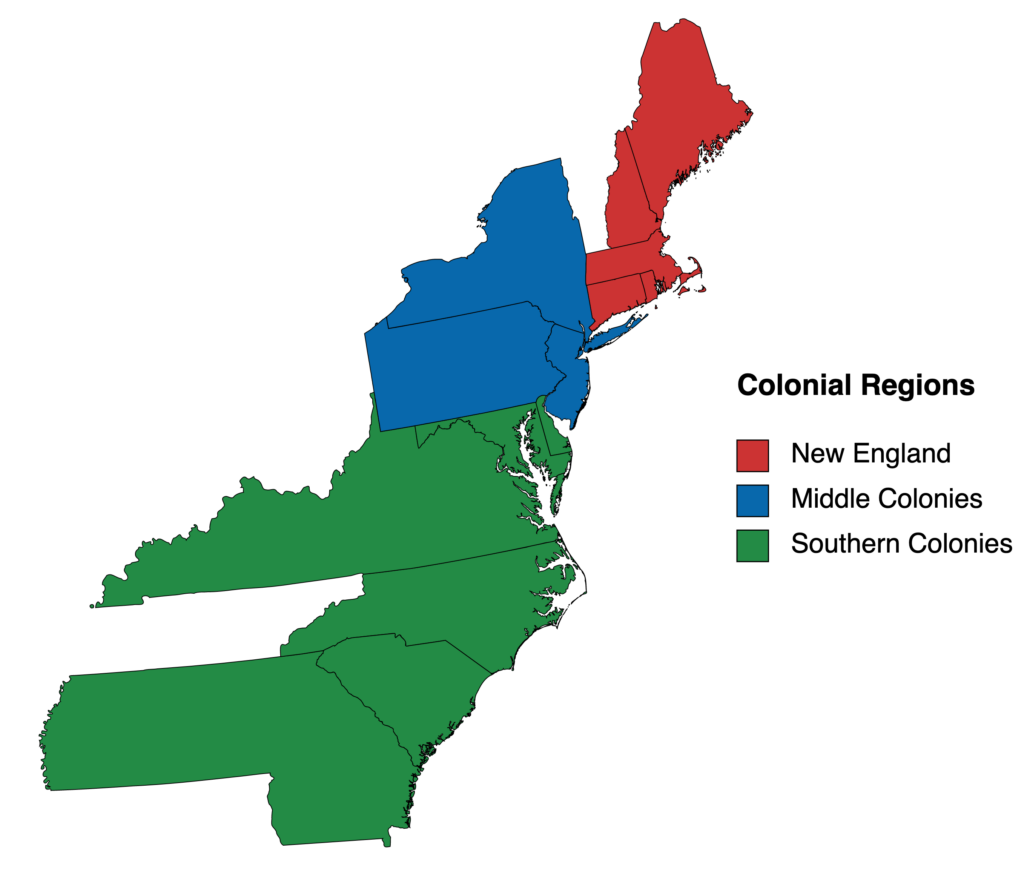Why did the colonies develop differently?
As with any community, the North American colonies continued to develop and change based on unique climates, natural resources, and weather within each territory. The colonial regions did not share the same features, so each region tended to develop differently.

There were three distinct colonial regions: the New England Colonies, the Middle Colonies, and the Southern Colonies.
New England Colonies
The New England Colonies (Connecticut, Rhode Island, Massachusetts, and New Hampshire) were the northernmost colonies. Their land tended to be rocky and of poor quality, able to support only small family farms. The winters were long and cold, creating a short growing season but also limiting the spread of diseases transmitted more quickly in warmer climates. Given the lack of agriculture, the New England Colonies used their plentiful natural resources of timber, fishing, and whaling for trade to meet their economic needs.
Unlike other regions, the New England colonies did not offer their settlers religious freedom; each New England colony tended to follow a form of Puritan beliefs. The importance of religion in New England meant that every male needed to be able to read and write, so they could be the religious leaders of their families and participate in community meetings. In fact, a 1647 Massachusetts law required any town with a population of fifty or more families were required to support its own school. Thus, the New England colonies built more schools and had a more literate society than the other colonial regions.
Middle Colonies
The Middle Colonies (Delaware, Pennsylvania, New Jersey, and New York) were settled on varied land: some areas could support large-scale farming, while others relied on abundant natural resources like furs and iron ore to assist economic trade.
Colonists in the Middle Colonies were allowed religious freedom, and their predominant denominations were Quakers, Catholics, Lutherns, and Jews. As in New England, religion helped to create and support a literate population because of the need to read the Bible.
Southern Colonies
The Southern Colonies (Maryland, Virginia, North Carolina, South Carolina, and Georgia) were settled among rolling hills and pine forests. This created an ideal area for large-scale farming, and plantation systems emerged for growing rice, sugar cane, indigo, and eventually cotton. The agricultural development in the South required more labor than in the other regions. At first, the need for labor was met with European indentured servants. Planters would pay the passage, room, and board for settlers in exchange for those settlers’ labor on the planters’ plantations, usually for seven to eight years. But as the demand for labor increased, there were not enough indentured servants available to meet it, so planters turned to slavery. The need for labor to operate plantations gave rise to the slave trade that developed in the Southern Colonies. Winters in the Southern Colonies were mild and allowed for the greater spread of disease, leading to shorter lives. In fact, disease was so rampant that many indentured servants did not live long enough to complete their contracts and earn their freedom. Many slaves also died from disease, among other unnatural causes.
The Southern Colonies allowed religious freedom; primary forms included Baptist and Anglican. As a result of the freedoms allowed in the Southern Colonies, religion did not dictate laws or social rules in the south. Therefore, schools and higher education were not a priority in the South because planters’ primary need was for unskilled laborers and agricultural production. Plantation owners wanted to make money, and anyone of any age could work in the fields. The planters’ children were often sent to Europe or hired tutors for their education. There was little formal education in the Southern Colonies.
Each of the colonies focused solely on its own success and development. Leaders of the Georgia colony, for example, did not consider the Massachusetts colony’s needs when making decisions.
Over time, this perspective will change, but it will take war and taxes to drive the colonies together.

